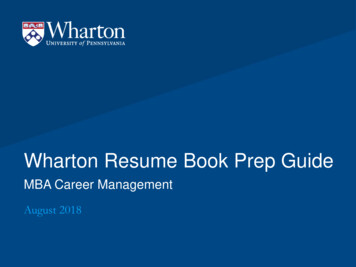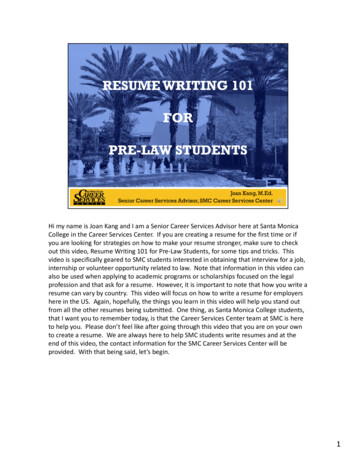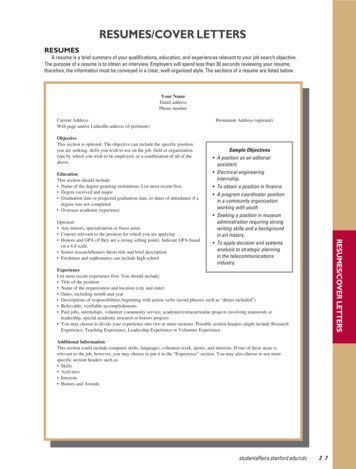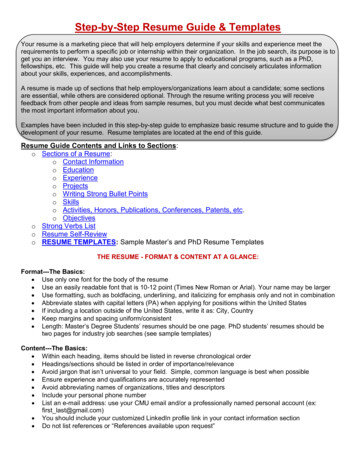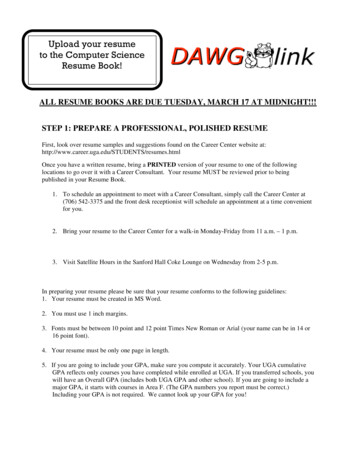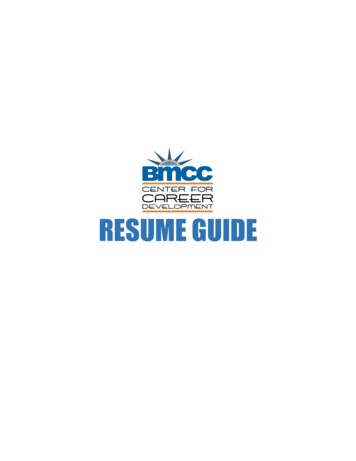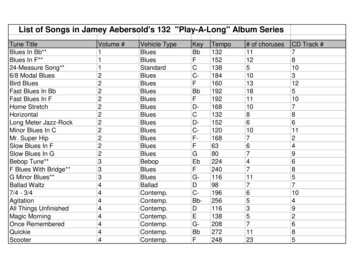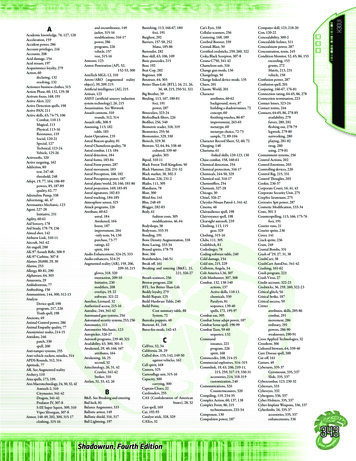
Transcription
DOCUMENT RESUMEED 132 422AUTHC'STITLEINSTIIUT1ONSFONS AGENCYPUB DATENOTEAVAILABLE FROMEDRS SLICEDESCRIPTORSCE 009 231Grubt, FrancineSewing: A Teacher's Guide to an EmploymentOrientation Course for Special Needs Students.Rutgers, The State Univ., New Brunswick, N.J.Curriculum Lab.New Jersey State Dept. of Education, Trenton. Eiv. ofVocational Education.Dec 7687p.; For related documents see CE 009 226-228 and CE009 230-232New Jersey Vocational-Technical CurriculumLaboratory, Bldg. 4103, Kilmsr Campus, RutgersUniversity, New Brunswick, New Jersey 08903 ( 2.50plus postage)MF- 0.83 HC- 4.67 Plus Postage.*Career Exploration; Curriculum; *DisadvantagedYouth; *Handicapped Students; InstructionalMaterials; *Job Skills; Lesson Plans; Seamstresses;Secondary Education; Semiskilled Occupations;*Service Occupations; *Sewing Instruction; SpecialEducation; Special Programs; Teaching GuidesABSTRACTThis teacher's guide on sewing is one of a seriez ofsix designed fcr the employment orientation program for special r.;.,2sstudents at the Gloucester County Vocational-Technical School inSewell, New Jersey. The series includes laundry, hospitality, sewing,basic business, foods, and beauty culture. Each guide contains dailylesson plans consisting of objectives, subject matter covered,audiovisual aids, demonstrations, student activities, and evaluationsuggestions. The 30 lessons in the sewing guide are (1) Introductionto Sewing, (2) Hand Sewing Fundamentals, (3) Buttons and Fasteners,(4) Basting, (5) Backstitching and Overcasting, (6) Hemming, (7)Decorative Stitching, (8) Hand Sewing Project, (9) The SewingMachine, (10) Threading the Machine, (11) Winding the Bobbin, (12)Practice Sewing on Paper, (13) Sew a Straight Seam, (14) Sew a CurvedSeam, (15) Using the Throatplate Guides, (16) Backtacking andTopstitching, (17) French Seam, (18) Pattern Envelope, (19)Identification and Alteration of Pattern Pieces, (20) Guides forLayout and Cutting, (21) Cutting and Sexing Directions, (22) Guidesfor Ccnstruction, (23) Hoy to Cut and Hew to Mark, (24) Your PersonalMeasurement Chart, (25) Comparison of 'atterns, (26) Making Darts,(27) Zipper, (28) Buttonholes, (29) Repair Sewing, and (30) Project.Charts, masters for proje,;tuals, and a short-a,.swer sewing test arealso included. (HD)Documents acquired by ERIC include many informal unpublished materials not available from other sources. ERIC makes everyeffort to obtain the best copy available. Nevertheleu, items of marginal reproducibility are often encountered and this affects thequality of the microfiche and hardcopy reproductions ERIC makes aviiiable via the ERIC Document Reproduction Service (EDRS).EDRS is not responsible for the quality of the original document. Reproductions supplied by EDRS are the best that can be made fromthe original.
St,,tc of.1)cp.irtinvntVdticorior,olSEVV INC-- ATEACHER'S GUIDE TO AN EMPLOYMENT ORIENTATION COURSEFOR SPECIAL NEEDS STUDENTSFrancine Grubb, InstructorJoseph tif. English, DirectorC/oucester ounSewell , New jerseyCty Voonacati/- Technicll Schoo/OF HEALTH,&WELFAREU S ONHAS BEENFROMRECEIVE0UR VIEW OR REPREPERSON ORPOINTS OFOFTHEATITO IT DO NOT m LaboratoryThe State UniversityRutgersBuilding 4103lr:Aer CampusNew Brunswick, Neve JerseyDecember / 9762
NEW JERSEY DEP .RTMENT OF EDUCATIONFRED C. BURK F, CIMMISSIONERRALPH H. LAT AILI E. DEPUTY COMMISSIONERDIVISION OF VOCATIONA L EDLf ATIONWILLIAM WENZEL, ASSISTANT COMMISSIONER (ActinglJOHN E. RADVANY, PEPUTY ASSISTANT COMMISSIONERHAROLD R. SELTZER, DEPUTY ASSISTANT COMMISSIONER (Acting)BENJAMIN SHAPIRO, DIRECTOR, VOCATIONAL-CURRICULUM LABORATORYCURRICULUM LABORATORYRUTGERSTHE STATE UNIVERSITYBUILDING 4103KILMER CAMPUSNEW BRUNSWICK, NEW JERSEY3
FOREWORDThis mainral is or,: of aof six. dc,igned for the Employment Orienta:ionprogram at the (;loucester Count:, Voca-ional-Technical School. The school ;sashared-time facil'ity that has on,: groiT of students for approximately 3 hours in themorning and another group tor approximately 3 hours in the afternoo. TheE,,,ployment .-rient,:tion program is taught in six discrete units so that additionalstudents may he acconunodated if vacancies occur during thL year.'The sx areas coy 'red arc:LaundryHospitalitySewingBaso FusinessFoodsBeauty CultureAttheend of theyear, assessments arc made so that students can bcmainstreamed into a regular program the followin .(ear. Therefore our major goal is totry to mainstream each of the students in thc 'zimplovment Onentation program intoregular vocational shop areas. A secondary goal is to acquaint the students with specifictypes of employment in a particular trade or industry, so that the choice of a vocationalshop may be based on t'ae realities of the world of work as well as on the aptitudes ofthe particular student.All of the Special Needs students arc classified by their d.strict Child Study Teamand are screened for admission into the Employment Orientation Program by the SpecialNeeds Dep-rtment at Gloucester County Vocational-Technical Scaool.This cu-riculurn project includes daily class lesson plans, consisting of objectives,subject mattr covered, audiovisual aids,demonstrations, student activities, and evaluationsuggestions. The teacher is urged to make handouts out of all the audiovisuals and charts.Some of the instructional material suggested may, of course, prove to be toodifficult for some of the students. The teacher must, as always, tailor the material to theneeds of the individual. Conversely, a large number of student activities have beenincorporated into the program for those students who may progres faster than others.A math program accompanies these units to stress the necessity founderstanding of practical math. For example, linear measurement is raught csewing unit, and weights and measures is taught during the foods unit.ba-ictheIn some areas, particularly Beauty Culture, the teacher will not expect completememorization of all details covered, but should stress that these are included in thecourse content of a regular vocational course. The purpose is to give the student arealistic picturc of what the regular course would be like and what would be expected ifthat student chose that course to be mainstreamed into the following school year.4Francine Grubb
TABLE OF CONTENTSPageForewordObjectives of the Sewinc,ReferencesIntrouction to SewingLesson 1Hand Sewing FundamentalsLesson 2Buttons and FastenersHand SewingLesson 3Hand SewingBastingLesson 4Backstitching and OvercastingHand SewingLesson 5HemmingHand SewingLesson 6IDicorative StitchingHand SewingLesson 7Hand Sewing ProjectLesson 8Lesson 9 The Sewing MachineLesson 10 Threading the MachineWinding the BobbinLesson 11Lesson 12 Practice Sewing on PaperHow To Sew a Straight SeamLesson 13Lesson 14 - How To Sew a Curved SeamUsing the Throatplate GuidesLesson 15Lesson 16 Backtacking and TopstitchingLesson 17 The French SeamLesson 18 - The Pattern EnvelopeLesson 19 Identification and Alteration of Pattern PiecesLesson 20 Guides for Layout and CuttingCutting and Sewing DirectionsLesson 21Lesson 22 Guides for ConstructionLesson 23 How To Cut and How To MarkLesson 24 Your Personal Measurement ChartLesson 25 Comparison of PatternsLesson 26 - Making DartsLesson 27 The ZipperLesson 28 ButtonholesLesson 29Lesson 30Repair SewingThe 3343536373839Test on Sewing40Masters for Projectuals and Charts545-74
Objectives of the Sewing UnitUpon the completiol. of this unit the ,tudenr will be able to:1.Sew basic hand stitche.i and a few decoratiye hand stitches.2.Properly wind a bobbni3.Scw straight and curved seams, using the tliroatplate guides.4.Demonstrate how to read and follow a pattern cutting and layout guide.5.Cut a pattern and mark it correctly.6.Makedarts,insertatkread the nklchine.zipper(centeredandlapped)and make machine-madebuttonholes.7.Do simple repair work on shop uniforms and other garments.8.Help plan and carry out a sewing project done in a piecework, assembly-line fashion.6
ReferencesThe following manuals are published by the Vocational-Technical Curriculum Laboratory,Rutgers The State University, New Brunswick, N. J. 08903.The Art of SewingLearning to Sew ILearning to Sew 11Needle TradesCourse of Study OutlinePower SewingKnow Your Pattern"includes large charts and teacher's guideSimplicity Educational Division20u Madison AvenueNew York, New York 10016Sample pattern envelopes and pattern size-charts available fromMcCall Pattern CompanyEducation Department230 Park AvenueNew York, New York 10017Sewing booklets on various techniquas fromCoats and Clark, Inc.Educational Bureau430 Park AvenueNew York, New York 10022Booklets, charts, and various instructions available fromThe Singer CompanyEducation Department30 Rockefeller PlazaNew York, New York 100207iv
Lesson 1Introduction to SewingObjectivesAt the coniusion of this lesson the student will be able to:Identify the tools that are necded for sewing.--Properly and safely use the basic tools found in the sewing box.Recognize thc importance of knowing how to sew.-Realize that shop sai-:tv is a very important factor in sewing.-KnoW the types of jobs available in tH needle-trades industries.MethodA. Lecturediscussion1. Some basic reasons for learning to sew1. Job dcscriptions in thc needle trades3. The importance of shop safety in the sewing room4. The sewing box and its basic tools5. The proper and safe use of:thimbleb. scissorsa.c.pincushiond. ruler, yardstick, tapemeasure and gagec. needles and pinsf. threadB. AudiovisualnoneC. DemonstrationTeacher will demonstrate the proper use of each of the tools in the sewing box,stressing safety throughout.Teacher preparationA. Gather lecture notes.B. Gather materials for use in lecture and demonstration.1
Student activitiesA. Students will gather materials to he used in their sewing boxes.B. Students will answer the teacher's questions on whether they have already hadsewing in school.EvaluationTeacher will evaluate students on their contributions to the discussion durine, thelecture period.92
Lesson 2Hand-SewingFundamentalsObjectivesAt the conclusion of this lesson the stydent will be able to:-Properh, thread a needle.--Make a knot at the end of the thread.Determine how much thread is to be used.Properly use a thimble.End a line of hand sewing.MethodA. LecturediscussionTile thread should be about 20 inches long (the length of thc arm).2. How to thread the needle3. Making a knot at the end of the thread4. Using the buttonhole stitch to begin sewing1.5.Ending a line of hand sewinga. Three small slant stitchesb. Buttonhole stitch6. Using the thimbleB. AudiovisualnoneC. DemonstrationTeacher will demonstrate threading the needle, knotting the thread, usingbuttonhole stitch to begin sewing, and ending a line of hand stitching.Teacher preparationA. Gather lecture notes.B. Gather materials for demonstration and student activities.310a
Student activitiesA. Students will diread needle and make a knot in the diread.B. Students will demonstrate a buttonhole stitch.C. Students will end a line of basting.I). Snidents will end a line of stitching.EvaluationStudents wdl be evaluated individuall'y on the student activities.11
Hand SewingL esson 3Buttons and FastenersObjectivesAt the conclusion of this lesson the student will IA:to:--Sew hooks and eves onto a piece of fabric.--Sew snap fasteners onto a piece of fabric.Sew shank buttons and four-hole buttons onto a piece of fabric.MethodA. Lecturediscussion1. What are hooks and eyes and where are they used?1. What are snap fasteners and when are they used?3. The two-basic types of buttons are.a. shank typeb. four- or two-hole flat type4. Different uses of bui:tonsa.practicalb. decorativeB. AudiovisualnoneC. Demonstration1. Teacher will demonstrate how to sew hooks and eyes.2. Teacher will demonstrate how to sew snap fasteners.3. Teacher will demonstrate how to sew various types of buttons.Teacher preparationA. Gather lecture notes.B. Gather materials for demonstration and student activities.512
Student activitiesA. Students will practice sewing hooks and eves.B. Students will practice sewing snap fasteners.C. Students will practice sewing various types of buttons.EvaluationTeacher will evaluate each student individua:13ch of the student activities.
rcsson 4Hand SewingA11 (t 111cII.111,1, nrIII hcBastingf()!,i11 1%111hC),'1.k.'11.(Ii,iv,)11,t1.11'111)11111V 1).e.riritr7 it eh .Met huilA.c, fiNI1,,.,(11.,.,1,01WIlcrl2.i\AdicllI.,4. \A/lieriR.I11 (.111Whctl'.717(1)LII 1,111eVrIl 11.V.C171t,, %titC11 11',ed"'h.1711(111111V 1).1',C1I1V,IAIIINviII,lI11,111(I koiorr,tt.itionIeven l),ht ifig t it) It.'14%11 her will dellinted raw4,lillcveli baStillg Stitt'IVA( Ilr will driiimPar.ite a diagonal basting stitch.'Ira( her will demon.trate a running, basting stitch.(114 r lel2.3,AI r.1) hr will d(ilit)te.tr,at(iireII( ;Abet 111.11Cr1.11'. Ilrydrd fill dell10114.11',ItilIll!it mien! .i I iVil Ir.,will pf.1(r (.14 Ii of I lir 141)w/illy, ba%lji)).!I. cven basting,2,3.4.uneven Listing,diag,onal kraing,running stio IiITea, her will evaluate students individually on each (.1 the tItclitti ill the tittulenttivit y714
f.eson 5Hand SewingBackstitching and OvercastingtivesAt the conclusion of this lesson the student will be able to:Sew a backstitch on a piece of fabric.Nercast the edge of a piece of material.tvIethodA. Lecturediscussion1. When do we use the backstitch?2. When di, we use overcasting?l.Audiovisualnonec. Demonstration1. Teacher will demonstrate the backstitch.2. 'Teacher will demonstrate overcasting.Teacher preparationA. Gather lecture notes.B. Gather materials needed for demonstration and student activities.Student activitiesA. Students will practice the backstitch.B. Students will practice overcasting the edge of a piece of material.Students will he evaluated indiviclually on the student activities.158
Hand SewingLesson 6HemmingObjectiveAt tle conclusion of this lesson the student will be able to:Demonstrate the proper way of sewing a blind hem stitch.MethodA. Lecturediscussion1. Hemming is probably the mo3t useful stitch to learn.2. Thc type of fabric being hemmed is an important factor.3. The stitch should not sb iw on the right side of the material.B AudiovisualA.V. 6Blind HemC. DemonstrationThe teacher will demonstrate theranging from sheer to bulky.tind hem stitch on several types of materials,Teacher preparationA. Gather lecture notes.B. Gather materials needed for demonstration and student activities.Student activitiesStudents will practice a blind hem stitch on several types of materials, rangingfrom sheer to bulky.EvaluationStudents will be evaluated individually on their hemming.916
Hand SewingLesson 7Decorative StitchingObjectivesAt the conclusion of this lesson the student will be able to:Sew a chainstitch.--Sew the cross-stitch.--Sew an outline stitch.--Decorate a piece of material using a satin stitch.--Plan a project using the tec'lniques of hand sewing already mastered.MethodA. Lecturediscussio1. What is decorative sewing?2. Where do you see decorative sewing?3. Plan a project using the techniques of hand sewing already mastered.B. AudiovisualnoneC. DemonstrationTeacher will demonstrate the chainstitch, cross-stitch, outline stitch, and satinstitch.Teacher preparationA. Gather notes for lecture.B. Gather materials needed for demonstration and student activity.Student activitiesA. The students will practice the four stitches demonstrated today:1. chainstitch2. cross-stitch3. outline stitch4. satin stitchB. Students will plan a project to be done tomorrow, using the techniques in handsewing they have already mastered.1017
EvaluationA. Students will be evaluated individually on the four decorative stitches.B. Students will be evaluated on thcir planning and its creativity for the projectto be done tomorrow1811
Lesson 8Hand SewingProjectObjectiveAt the completion of this lesson the student will be able to:--Prepare and present a project in hand sewing based on the planning from theprevious day.MethodA. LecturediscussionTeacher will guide the students in any way possible on their projects, but willnot teach in a lecture-discussion form.B. AudiovisualC. DemonstrationnonenoneTeacher preparationTeacher may want to bring in extra materials for any student who may not havebeen in class on the previous day and did not have time to prepare plans for aproject.Student activityStudents will work independently on their projects throughout the class time.Students will be evaluated on their projects for:Planning method2. Were materials ready?1.3. Creativity4. Neatness of project5. Were completed projects in conformity with the plans?1219
The Sewing MachineLesson 9ObjectivesAt the conclusion of this lesson, the student will be able to:--Identify the basic parts of the sewing machine.the machine.--Demonstrate proper care--Properly change the needle on the machine.MethodA. Lecturediscussion1. The basic parts of the sewing machine2. Comparison between two models of Singer machines3. Caring for your sewing machine4. How to change the needle on the sewing machine.B. AudiovisualnoneC. Demonstration1. The teacher will demonstrate the proper care of the sewing machine.2. The teacher will demonstrate how to change the needle on the sewingmachine.A Touch and Sew machine and a regular bobbin machine will be used fordemonstration purposes.Teacher preparationA. Gather lecture notes.B. Be sure to have the two models of sewing machines available for classdemonstration.Student activityA. Students will point out the basic parts on both machines.B. Students will show how to properly care for the sewing machine.C. Students will practice changing the needle on the sewing machine.EvaluationStudents will be evaluated on the student activities.1320
Threading the MachineLessen 10ObjectivesAt the conclusion of this lesson the student will be able to:--Properly thread the Singer Touch and Sew machine.--Properly thread the Singer Zig-Zag machine Model 717.MethodA. LecturediscussionnoneB. AudiovisualsTwo largc charts put out by the Singer company showing how to thread thetwo machines indicated (available at small cost).C. DemonstrationTeacher will demonstrate how to thread the two different types of machines.Teacher preparationGather materials needed for demonstration (charts, machines, thread) and forstudent activity.Student activityStudents will practice threading the two different types of sewing machines.EvaluationTeacher will test to make sure students can thread both machines properly.1421
Lesson 11Winding the BobbinObjectivesAt the conclusion of this lesson the student will be able to:--Wind the bobbin in the Singer Touch and Sew machine.--Wind the bobbin in the Singer Zig-Zag machine Model 717.MethodA. LecturediscussionnoneB. Audiov. talTwo large charts distributed by Singer showing how to wind the bobbin andplace it in the machine on the two machines discussed. (available at small cost).C. Demonstration1. Teacher will demonstrate how to wind the bobbin on the Singer Touch andSew machine.2. Teacher will demonstrate how to insert an already-wound bobbin into themachine.3. Teacher will demonstrate how to wind the bobbin on the Singer Zig-Zagmachine.4. Teacher will demonstrate how to insert an already-wound bobbin into themachine.Teacher preparationGather materials needed for demonstration and student activity.Student activityA. Students will practice winding the bobbin and inserting an already-woundbobbin into the Singer Touch and Sew machine.B. Students will perform the same tasks on the Singer Zig-Zag machine.EvaluationTeacher will evaluate whether the students can wind and insert bobbins in bothmachines demonstrated.1522
Lesson 12Practice Sewing on PaperObjectivesAt the conclusion of this lesson the student will be able to:--Run the machine and keep it under control.--Sew straight lines, pivots, and circles.MethodA. Lecturediscussion1. The reason for sewing on paper2. Controlling the speed of the machineE. AudiovisualnoneC. DemonstrationTeacher IA! demonstrate on each of the student practice sheets that will begiven out in class:I. a. Aug straight lines2. sewing curved lines3. sewing pivotsTeacher preparationA. Gather lecturc notes.B. Be sure all materials are ready for the demonstration and student activity.C. Be sure to have enough student practice sheets.Student activityStudents will practice sewing (with thread) on each of the student practice sheetsgiven out in class.EvaluationTeacher will evaluate how well the student runs the machine by watching as thestudent sews on a test paper.1623
Lesson 13How to Sew a Straight SeamObjectiveAt the conclusion of this lesson the student will be able to:--Sew a straight seam, keeping the edges together and the machine under control.MethodA. Lecturediscussion1. Review of threading the machine, winding the bobbin, and preparing to sew.2. Discuss what happens when the machine runs too fast and goes out ofcontrol and how11"(.,mit this.B. AudiovisualA.V. 13The Plain ScamC. DemonstrationTeacher will demonstrate how to sew a straight seam.Teacher preparationA. Gather lecture notes.B. Gather materials needed for demonstration and student activity.Student activityStudents will practice scwing a straight scam.EvaluationStudents will be evaluated on:1. Correct threading of the machine.2. Correct placement of the bobbin.3. How straight was the scam?4. Were the edges of the material even?1724
Lesson 14How to Sew a Curved ScamObjectiveAt the conclusion of this le son the student will be able to:--Sew a curved seam, keeping the material edges even and the machine undercontrol.MethodA. LccturcdiscussionReview thc importance of kecping the machine at a controllable sPeed,especially when sewing a curved scam.B. AudiovisualA.V. 14The Curved SeamC. DcmonstrationThe teachel will demonstrate how to sew a curved seam.Teacher pr TarationBe sure to have materials together for demonstration and student activity.Student activityStudents will practice sewing a curved seam.EvaluationTeacher will evaluate students on the following criteria:1. Sewing preparation (Machine threaded correctly, etc.)2. Sewing technique (Was the speed controllable?)3. Neatness of project (How accurately done?)4. Proper cleanup of area.1825
Using the Throatplate GuidesLesson 15ObjectiveAt the conclusion of this lesson the student will be able to:Use the guidelines on the throatplate to help keep the seam straight.--Identify the numbers on the throatplate and explain their meaning.MethodA. Lect,,discussion1. The guidelines on the throatplate2. Their corresponding measurements3. How you can use the guide to help sew a straight seam.B. AudiovisualA.V. 15Throat Plate GuideC. DemonstrationTeacher will demonstrate the use of the guidelines on the throatplate.Teacher preparationA. Gather lecture notes.B. Gather materials for demonstration and student activity.Student activityStudents will be given pieces of unmarked material and will be required to makestraight scams, using the guidelines on the throatplate.EvaluationTeacher will evaluate each student individually on:1. Sewing preparation2. Sewing technique3. Neatness4. Cleanup1926
Backtacking and TopstitchingLesson 16ObjectivesAt the conclusion of this lesson the student will he able to:Properly end seam by back tacking.--Correctly topstitch 3 piece of material.MethodA. Lecturediscussion1. The seam must not be able to be pulled apart.2. Tying takes too much time.3. Backstitching is much stronger.4. Topstitching is a decorative stitch that shows on the outside of the garment.B. AudiovisualA.V. 16 TopstitchingC. Demonstration1. Teacher will demonstrate the proper way to end a seam by backtacking.2. Teacher will demonstrate topstitching.Teacher preparationA. Gather lecture notes.B. Gather materials for demonstration and student ativity.Student activityA. Students will practice backtacking to end a seam.B. Students will practice topstitching on a piece of material with a straight seamalready sewn by them.EvaluationTeacher will evaluate each student individually on:1. Sewing preparation2. Sewing technique3. Neatness4. Cleanup2027
The French SeamLesson 17ObjectiveAt the conclusion of this less,.ch. student will he ble to:tkinonstrate how to sew a French seam.MethodA. Lecturediscussion1. When is a French seam used?a. children's clothingb thin materials2. Why do we use the French scam for these sewing problems?B. AudiovisualnoneC. DemonstrationTeacher will demonstrate how to make a French seam.Teacher preparationA. Gather 'cture notesB. Gather materials for demonstration and student activity.Student activityStudents will practice making a French seam.EvaluationTeacher will evaluate each student individually on:1. Sewing preparation2. Sewing technique3. Neatness4. Ck anup2128
Lesson 18The Pattern EnvelopeObjectivesAt the conclusion of this lesson the student will be able to:Find the yardage requirements from the back of a pact( rn envelope.-Identify fabrics that have nap and require special vard41:.MethodA. Lecturediscussion1. What is on the back of the pattern envelop?a. Garment descriptionb. Back viewsc. Illustrations of the pattern piecesd. Notions and interfacing requirede. Fabric suggestions2. What is "nap"?B. Audiovisuals1. Each student. will have a sample pattern envelope. (Simplicity and McCall's)2. Pattern Envelope front and back (A.V. 18a and 18b)C. Demonstration1. Teacher will demonstrate the difference between napped and unnappedmaterials.2. Teacher will demonstrate how to lay out pattern pieces on napped material.Teacher preparationA. Gather lecture notes.B. Be sure to have audiovisual materials together.C. Gather materials needed for student activities.Student activitiesStudents will examine the backs of several different pattern envelopes anddetermine how much material is needed for various styles, sizes, and fabrics.Students will make a shopping list of exactly what would be needed for aparticular style, size, and fabric.2229
B. From samples of different fabrics, students will choose fabrics that would besuitable according to the fabric suggestions on various patterns.EvaluationTeacher will evaluate students individually on their student activities.3023
Lesson 19Identification and Alteration of Pattern PiecesObjectivesAt the conclusion of this lesson the student will be able to:--Identify pattern pieces by the style number, pattern-piece name, and letter.--Select all the pieces needed to complete a particular view.--Demonstrate how to lengthen or shorten a pattern on the double line.MethodA. Lecturediscussion1. Identification of pattern pieces2. How do you lengthen or shorten a pattern piece?3. Why can't all pattern pieces be lengthened or shortened at the lower edge?B. Audiovisual1. Each student will have one or more pieces from a commercial pattern foridentification.2. Teacher will have a chart showing identification symbols and alterationlines.(Large McCall's chart, available from the company).C. DemonstrationTeacher will demonstrate how to lengthen or shorten a pattern.Teacher preparationA. Gather lecture notes.B. Be sure to have audiovisual materials together.C. Gather materials needed for demonstration and student activity.Student activityA. Students will identify typical pattern pieces by style number, name, and letter.B. Using the complete contents of the pattern envelope, students will sort out allthe pattern pieces that would be needed for a particular view.C. Students will practice lengthening and shortening pattern pieces as the teacherindicates.EvaluationTeacher will evaluate each student individually on the student activities.2431
Guides for Layout and CuttingLesson 20ObjectivesAt the conclusion of this lesson the student will be able to:--Identify the markings ri thc pattern for layout and cutting.--Identify the grain of a fabric and lay out pattern pieces on thc straight grainand on the fold.--Read all instructions on the layout guide and on the pattern pieces.---Know that no cutting is to bc done until all i. ructions for layout have beenfollowed.MethodA. Lecture1.discussionIdentify the grainof a fabric and stress importance of grain intheconstruction of a garment.Stress the differences between laying a piece on the straight grain andlaying on the fold.3. Stress importance of reading special instructions printed on the pattern.2.4. Why it is easier to cut off the pattern margin and cat out the fabric at thesame time than to do the two operations separately?B. Audiovisuals1.Each student will have a sample pattern.2. Teacher will have a large chart (Simplicity) pointing out the guides forlayout and cutting.C. Demonstration1. Teacher will demonstrate what is meant by cutting on the fold by cuttingout a paper doll and opening it up.2. Teacher will demonstrate what happens when pattern pieces are not cutaccording to indicateddemonstration.)grain.2532(Checked ginghamisgoodforthis
Teacher preparationA. Gather lecture notes.B. Gather audiovisual materials.C. Gather materials needed for demonstration and student activity.Student activityStudents will practice laying out pattern pieces on the straight grain and on thefold.EvaluationTeacher will evaluate each student individually on the student activity.3326
Cutting and Sewing DirectionsLesson 21ObjectivesAt the conclusion of this lesson the student will be able to:--Follow the guide sheet in laying out the fabric and pattern pieces.--Read all instructions before cutting.--Pin pattern pieces to fabric correctly.MethodA. Lecturediscussion1. Find the correct layout and circle it.2. Look for cutting "notes" and circle them.3. Mark an outline with pins or rhalk for pattern pieces that will be
DOCUMENT RESUME ED 132 422 CE 009 231 AUTHC'S Grubt, Francine TITLE Sewing: A Teacher's Guide to an Employment. Orientation Course for Special Needs Students. INSTIIUT1ON Rutg


